Innovation Management: A Case Study of Blue Ocean Strategy
VerifiedAdded on 2023/06/08
|12
|3462
|399
Essay
AI Summary
This essay provides a comprehensive analysis of the Blue Ocean Strategy as an innovation theory, contrasting it with disruptive innovation and detailing its principles and processes. It uses Starbucks as a case study to illustrate the strategy's historical development and potential future applications. The essay evaluates the benefits, such as reduced competition and higher margins, against limitations like the difficulty in finding suitable markets and the potential for later competition. The analysis covers the strategy's application in creating uncontested market spaces and attracting new customers, highlighting Starbucks' success in establishing a coffee culture and customer loyalty through innovative practices like mobile payments and loyalty programs. It concludes by emphasizing the importance of continuous innovation and adaptation to maintain a competitive edge in the evolving business landscape.
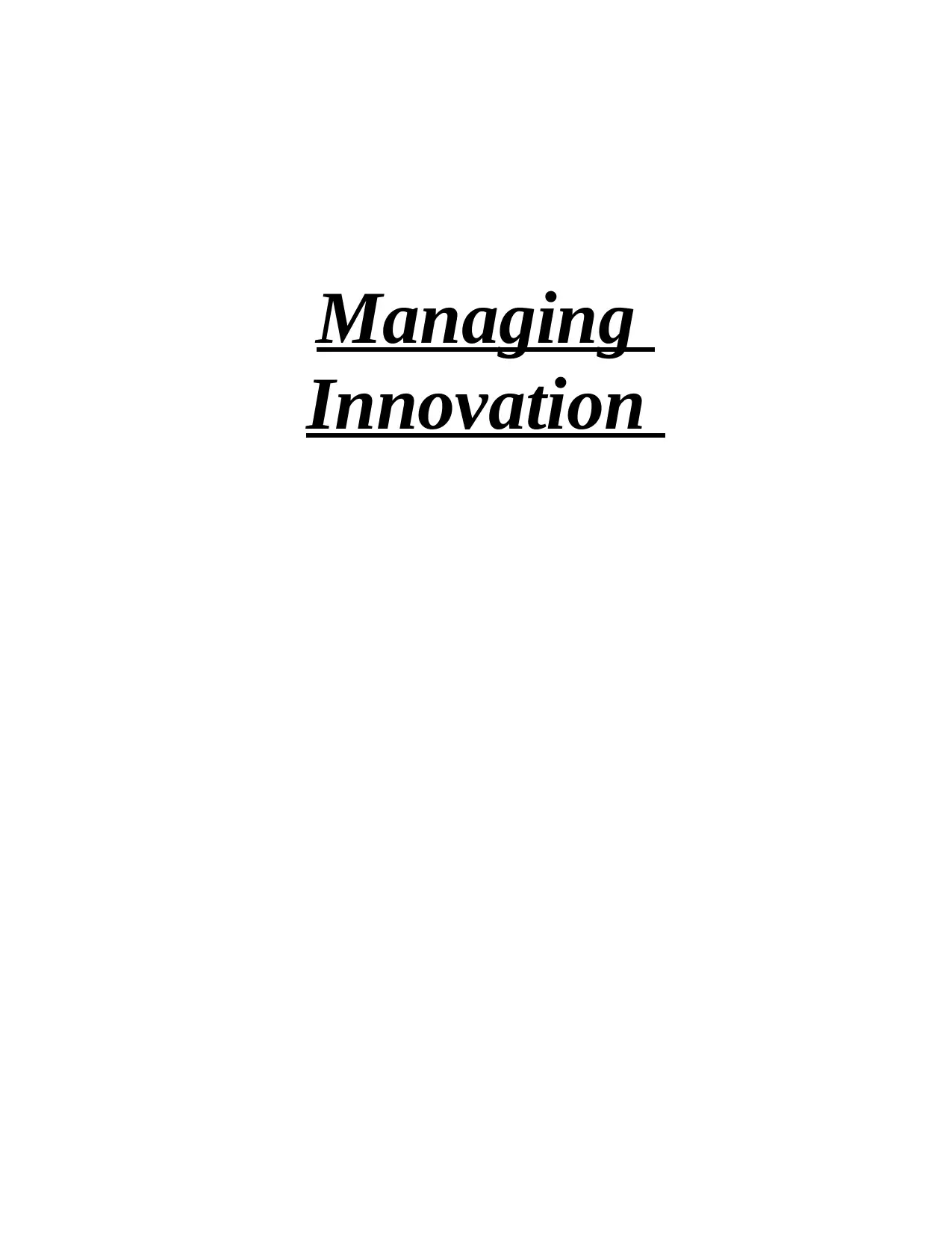
Managing
Innovation
Innovation
Paraphrase This Document
Need a fresh take? Get an instant paraphrase of this document with our AI Paraphraser
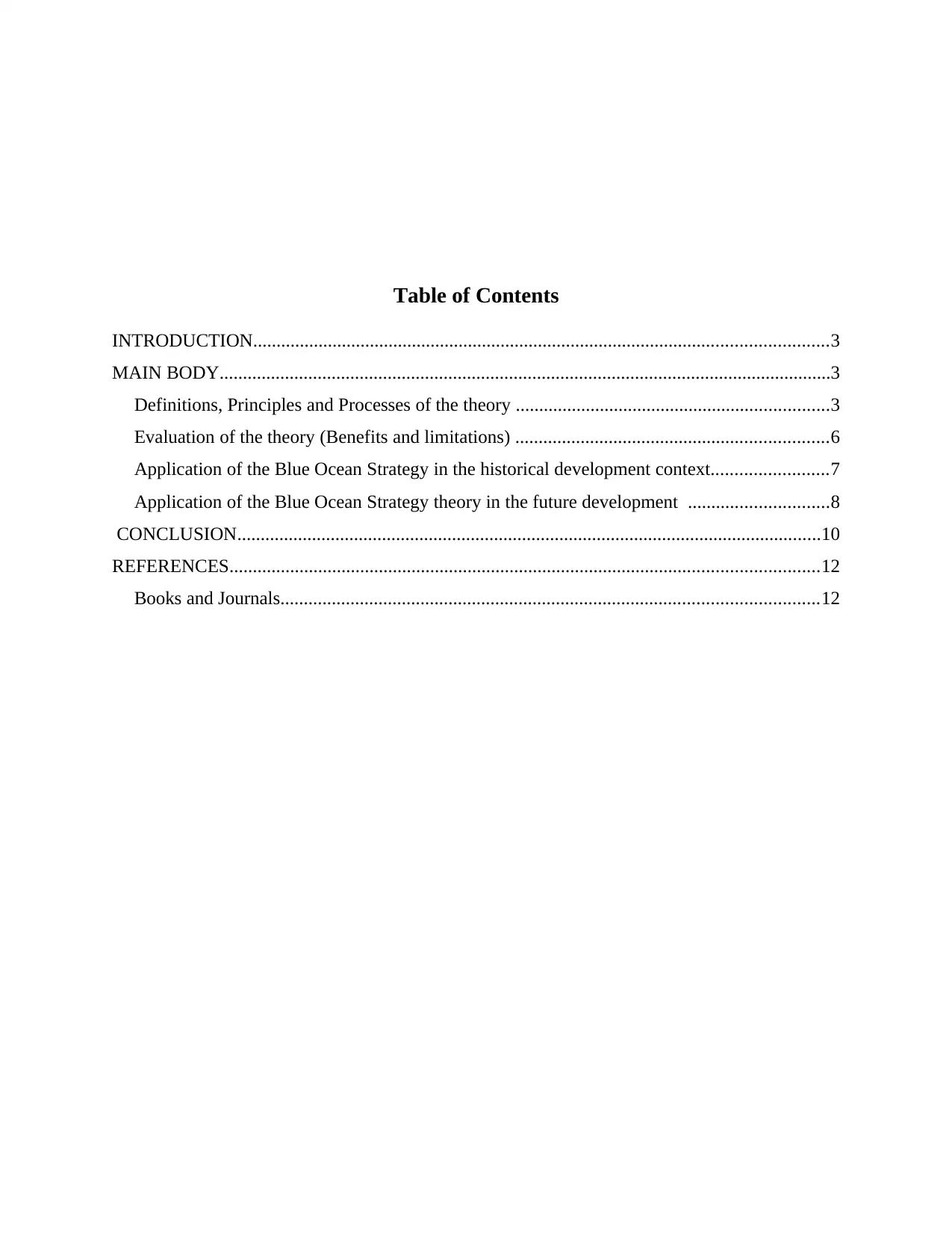
Table of Contents
INTRODUCTION...........................................................................................................................3
MAIN BODY...................................................................................................................................3
Definitions, Principles and Processes of the theory ...................................................................3
Evaluation of the theory (Benefits and limitations) ...................................................................6
Application of the Blue Ocean Strategy in the historical development context.........................7
Application of the Blue Ocean Strategy theory in the future development ..............................8
CONCLUSION.............................................................................................................................10
REFERENCES..............................................................................................................................12
Books and Journals...................................................................................................................12
INTRODUCTION...........................................................................................................................3
MAIN BODY...................................................................................................................................3
Definitions, Principles and Processes of the theory ...................................................................3
Evaluation of the theory (Benefits and limitations) ...................................................................6
Application of the Blue Ocean Strategy in the historical development context.........................7
Application of the Blue Ocean Strategy theory in the future development ..............................8
CONCLUSION.............................................................................................................................10
REFERENCES..............................................................................................................................12
Books and Journals...................................................................................................................12
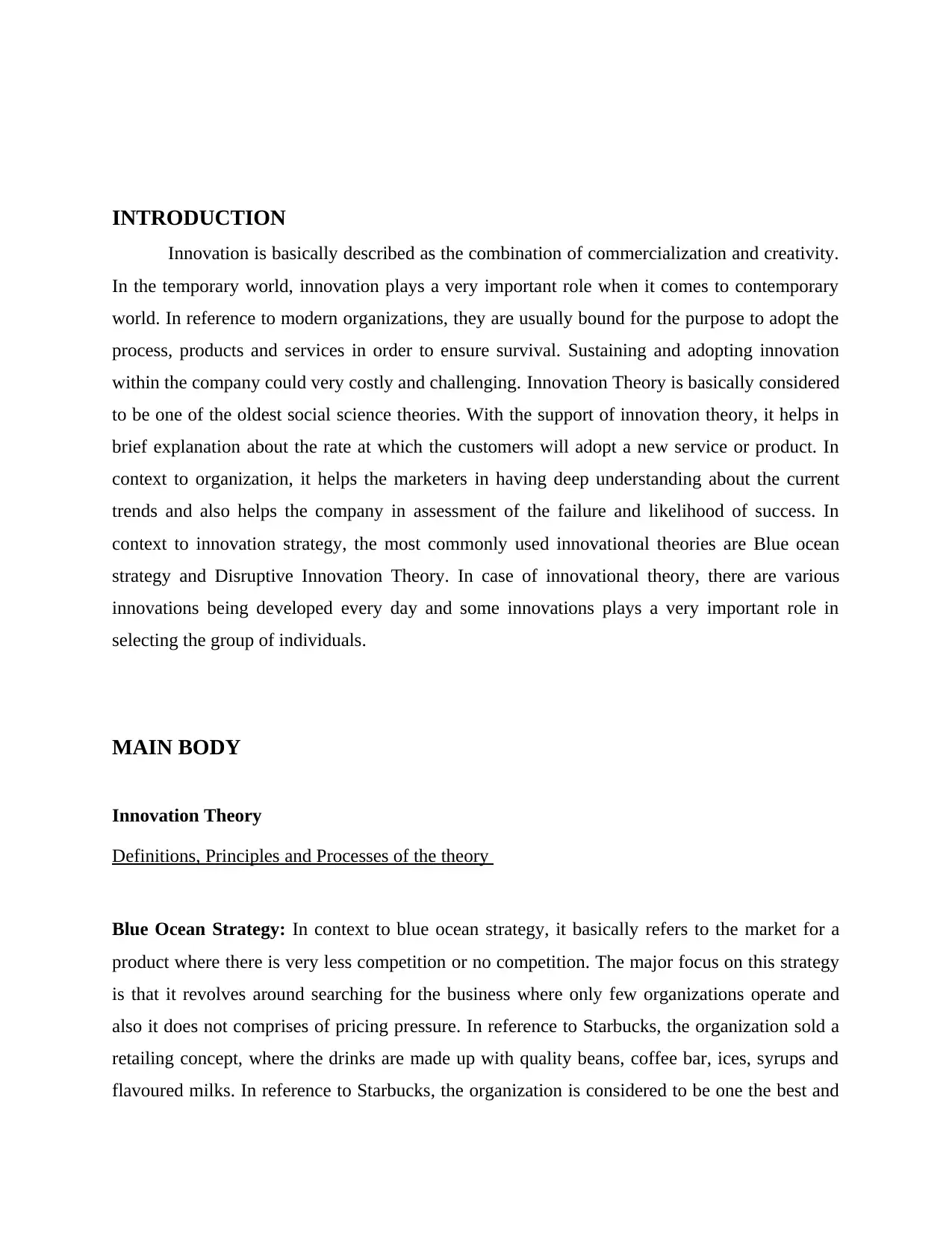
INTRODUCTION
Innovation is basically described as the combination of commercialization and creativity.
In the temporary world, innovation plays a very important role when it comes to contemporary
world. In reference to modern organizations, they are usually bound for the purpose to adopt the
process, products and services in order to ensure survival. Sustaining and adopting innovation
within the company could very costly and challenging. Innovation Theory is basically considered
to be one of the oldest social science theories. With the support of innovation theory, it helps in
brief explanation about the rate at which the customers will adopt a new service or product. In
context to organization, it helps the marketers in having deep understanding about the current
trends and also helps the company in assessment of the failure and likelihood of success. In
context to innovation strategy, the most commonly used innovational theories are Blue ocean
strategy and Disruptive Innovation Theory. In case of innovational theory, there are various
innovations being developed every day and some innovations plays a very important role in
selecting the group of individuals.
MAIN BODY
Innovation Theory
Definitions, Principles and Processes of the theory
Blue Ocean Strategy: In context to blue ocean strategy, it basically refers to the market for a
product where there is very less competition or no competition. The major focus on this strategy
is that it revolves around searching for the business where only few organizations operate and
also it does not comprises of pricing pressure. In reference to Starbucks, the organization sold a
retailing concept, where the drinks are made up with quality beans, coffee bar, ices, syrups and
flavoured milks. In reference to Starbucks, the organization is considered to be one the best and
Innovation is basically described as the combination of commercialization and creativity.
In the temporary world, innovation plays a very important role when it comes to contemporary
world. In reference to modern organizations, they are usually bound for the purpose to adopt the
process, products and services in order to ensure survival. Sustaining and adopting innovation
within the company could very costly and challenging. Innovation Theory is basically considered
to be one of the oldest social science theories. With the support of innovation theory, it helps in
brief explanation about the rate at which the customers will adopt a new service or product. In
context to organization, it helps the marketers in having deep understanding about the current
trends and also helps the company in assessment of the failure and likelihood of success. In
context to innovation strategy, the most commonly used innovational theories are Blue ocean
strategy and Disruptive Innovation Theory. In case of innovational theory, there are various
innovations being developed every day and some innovations plays a very important role in
selecting the group of individuals.
MAIN BODY
Innovation Theory
Definitions, Principles and Processes of the theory
Blue Ocean Strategy: In context to blue ocean strategy, it basically refers to the market for a
product where there is very less competition or no competition. The major focus on this strategy
is that it revolves around searching for the business where only few organizations operate and
also it does not comprises of pricing pressure. In reference to Starbucks, the organization sold a
retailing concept, where the drinks are made up with quality beans, coffee bar, ices, syrups and
flavoured milks. In reference to Starbucks, the organization is considered to be one the best and
⊘ This is a preview!⊘
Do you want full access?
Subscribe today to unlock all pages.

Trusted by 1+ million students worldwide
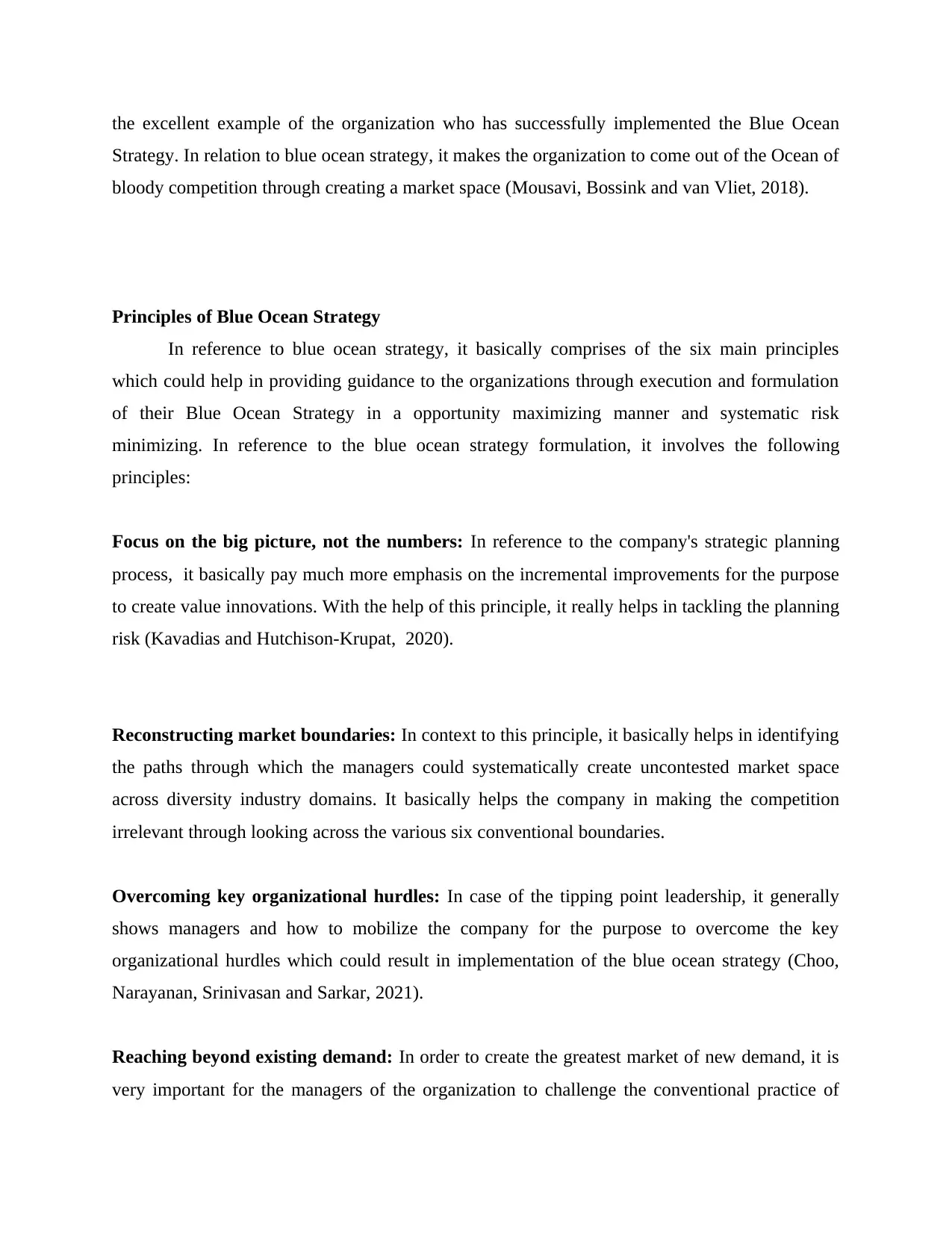
the excellent example of the organization who has successfully implemented the Blue Ocean
Strategy. In relation to blue ocean strategy, it makes the organization to come out of the Ocean of
bloody competition through creating a market space (Mousavi, Bossink and van Vliet, 2018).
Principles of Blue Ocean Strategy
In reference to blue ocean strategy, it basically comprises of the six main principles
which could help in providing guidance to the organizations through execution and formulation
of their Blue Ocean Strategy in a opportunity maximizing manner and systematic risk
minimizing. In reference to the blue ocean strategy formulation, it involves the following
principles:
Focus on the big picture, not the numbers: In reference to the company's strategic planning
process, it basically pay much more emphasis on the incremental improvements for the purpose
to create value innovations. With the help of this principle, it really helps in tackling the planning
risk (Kavadias and Hutchison-Krupat, 2020).
Reconstructing market boundaries: In context to this principle, it basically helps in identifying
the paths through which the managers could systematically create uncontested market space
across diversity industry domains. It basically helps the company in making the competition
irrelevant through looking across the various six conventional boundaries.
Overcoming key organizational hurdles: In case of the tipping point leadership, it generally
shows managers and how to mobilize the company for the purpose to overcome the key
organizational hurdles which could result in implementation of the blue ocean strategy (Choo,
Narayanan, Srinivasan and Sarkar, 2021).
Reaching beyond existing demand: In order to create the greatest market of new demand, it is
very important for the managers of the organization to challenge the conventional practice of
Strategy. In relation to blue ocean strategy, it makes the organization to come out of the Ocean of
bloody competition through creating a market space (Mousavi, Bossink and van Vliet, 2018).
Principles of Blue Ocean Strategy
In reference to blue ocean strategy, it basically comprises of the six main principles
which could help in providing guidance to the organizations through execution and formulation
of their Blue Ocean Strategy in a opportunity maximizing manner and systematic risk
minimizing. In reference to the blue ocean strategy formulation, it involves the following
principles:
Focus on the big picture, not the numbers: In reference to the company's strategic planning
process, it basically pay much more emphasis on the incremental improvements for the purpose
to create value innovations. With the help of this principle, it really helps in tackling the planning
risk (Kavadias and Hutchison-Krupat, 2020).
Reconstructing market boundaries: In context to this principle, it basically helps in identifying
the paths through which the managers could systematically create uncontested market space
across diversity industry domains. It basically helps the company in making the competition
irrelevant through looking across the various six conventional boundaries.
Overcoming key organizational hurdles: In case of the tipping point leadership, it generally
shows managers and how to mobilize the company for the purpose to overcome the key
organizational hurdles which could result in implementation of the blue ocean strategy (Choo,
Narayanan, Srinivasan and Sarkar, 2021).
Reaching beyond existing demand: In order to create the greatest market of new demand, it is
very important for the managers of the organization to challenge the conventional practice of
Paraphrase This Document
Need a fresh take? Get an instant paraphrase of this document with our AI Paraphraser
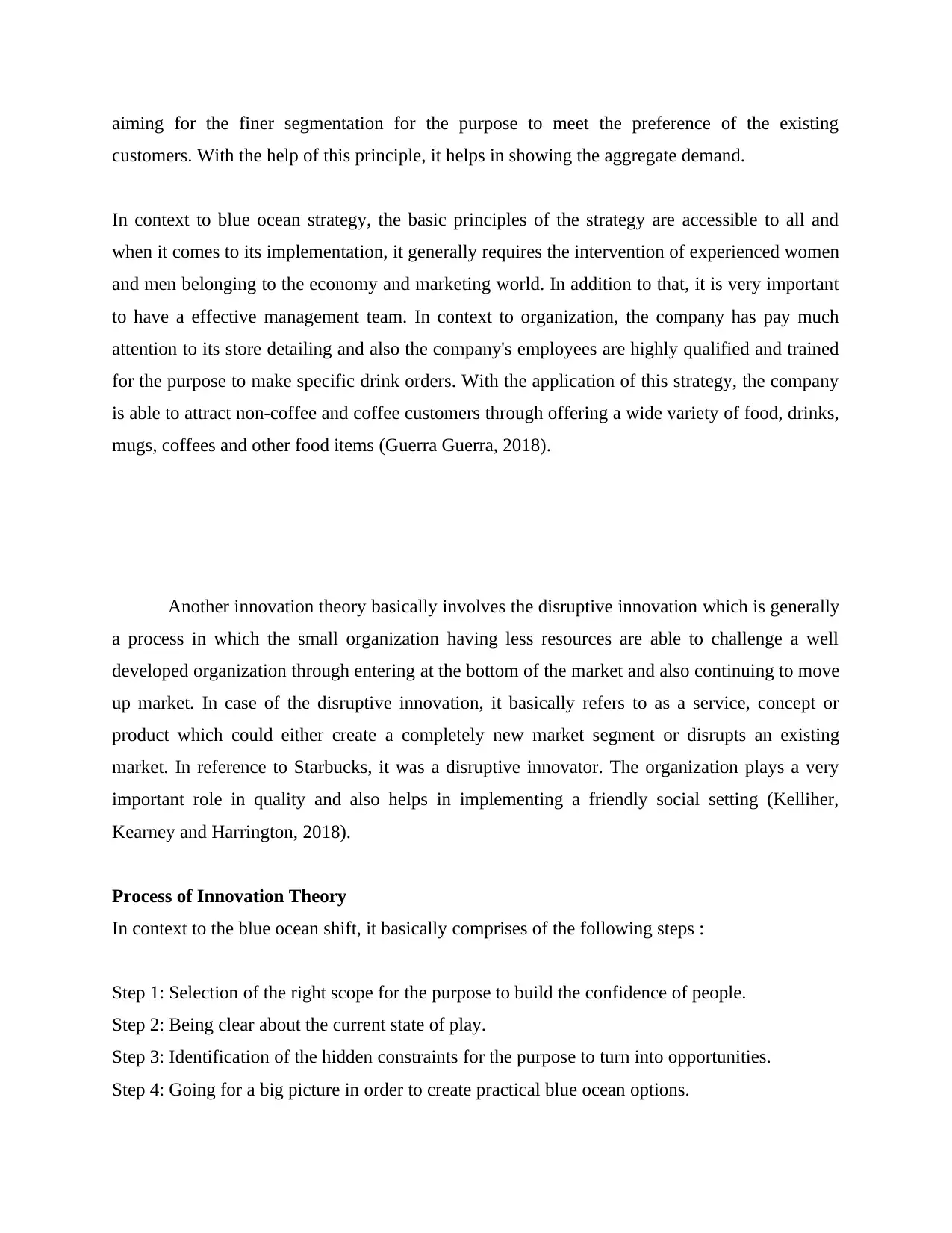
aiming for the finer segmentation for the purpose to meet the preference of the existing
customers. With the help of this principle, it helps in showing the aggregate demand.
In context to blue ocean strategy, the basic principles of the strategy are accessible to all and
when it comes to its implementation, it generally requires the intervention of experienced women
and men belonging to the economy and marketing world. In addition to that, it is very important
to have a effective management team. In context to organization, the company has pay much
attention to its store detailing and also the company's employees are highly qualified and trained
for the purpose to make specific drink orders. With the application of this strategy, the company
is able to attract non-coffee and coffee customers through offering a wide variety of food, drinks,
mugs, coffees and other food items (Guerra Guerra, 2018).
Another innovation theory basically involves the disruptive innovation which is generally
a process in which the small organization having less resources are able to challenge a well
developed organization through entering at the bottom of the market and also continuing to move
up market. In case of the disruptive innovation, it basically refers to as a service, concept or
product which could either create a completely new market segment or disrupts an existing
market. In reference to Starbucks, it was a disruptive innovator. The organization plays a very
important role in quality and also helps in implementing a friendly social setting (Kelliher,
Kearney and Harrington, 2018).
Process of Innovation Theory
In context to the blue ocean shift, it basically comprises of the following steps :
Step 1: Selection of the right scope for the purpose to build the confidence of people.
Step 2: Being clear about the current state of play.
Step 3: Identification of the hidden constraints for the purpose to turn into opportunities.
Step 4: Going for a big picture in order to create practical blue ocean options.
customers. With the help of this principle, it helps in showing the aggregate demand.
In context to blue ocean strategy, the basic principles of the strategy are accessible to all and
when it comes to its implementation, it generally requires the intervention of experienced women
and men belonging to the economy and marketing world. In addition to that, it is very important
to have a effective management team. In context to organization, the company has pay much
attention to its store detailing and also the company's employees are highly qualified and trained
for the purpose to make specific drink orders. With the application of this strategy, the company
is able to attract non-coffee and coffee customers through offering a wide variety of food, drinks,
mugs, coffees and other food items (Guerra Guerra, 2018).
Another innovation theory basically involves the disruptive innovation which is generally
a process in which the small organization having less resources are able to challenge a well
developed organization through entering at the bottom of the market and also continuing to move
up market. In case of the disruptive innovation, it basically refers to as a service, concept or
product which could either create a completely new market segment or disrupts an existing
market. In reference to Starbucks, it was a disruptive innovator. The organization plays a very
important role in quality and also helps in implementing a friendly social setting (Kelliher,
Kearney and Harrington, 2018).
Process of Innovation Theory
In context to the blue ocean shift, it basically comprises of the following steps :
Step 1: Selection of the right scope for the purpose to build the confidence of people.
Step 2: Being clear about the current state of play.
Step 3: Identification of the hidden constraints for the purpose to turn into opportunities.
Step 4: Going for a big picture in order to create practical blue ocean options.
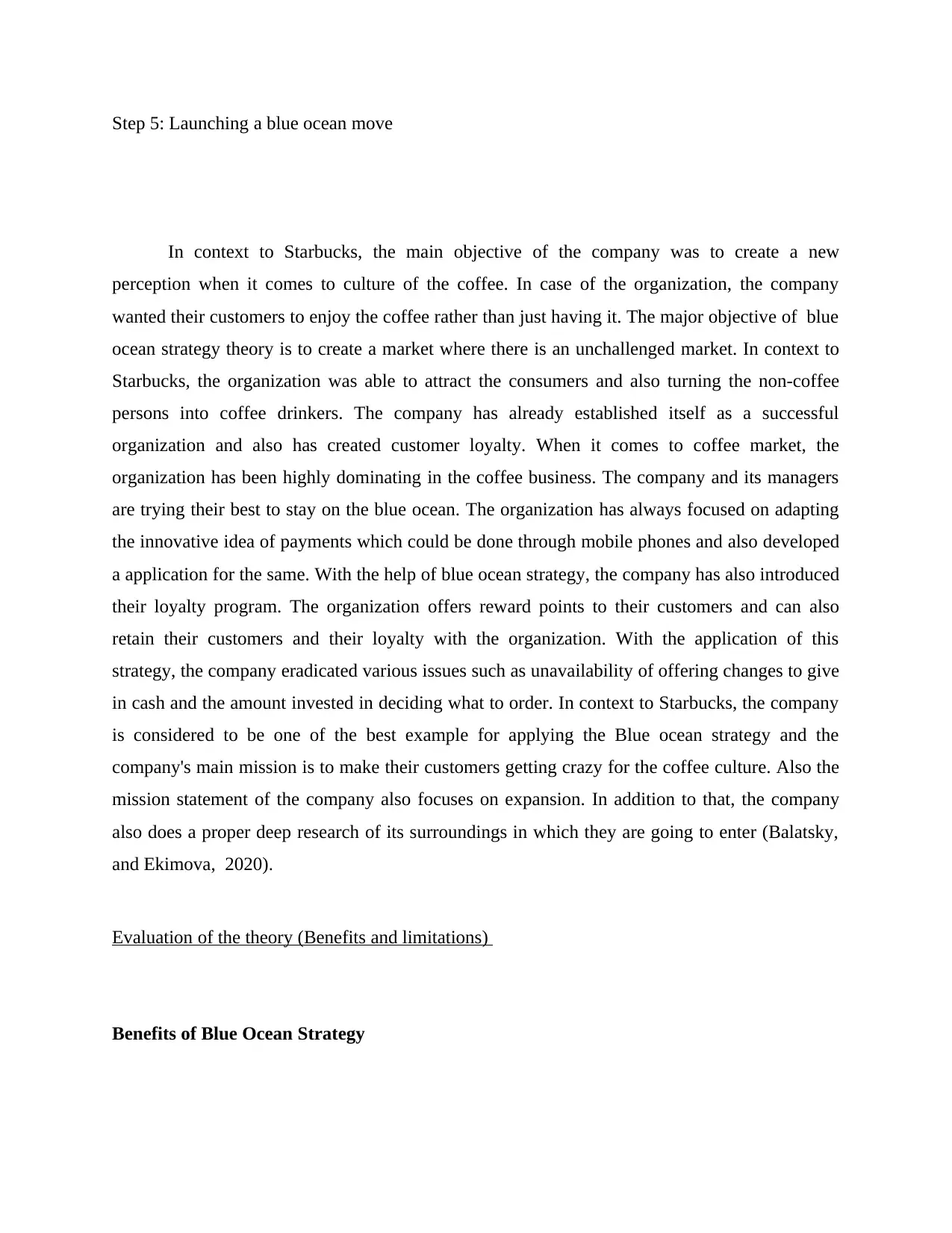
Step 5: Launching a blue ocean move
In context to Starbucks, the main objective of the company was to create a new
perception when it comes to culture of the coffee. In case of the organization, the company
wanted their customers to enjoy the coffee rather than just having it. The major objective of blue
ocean strategy theory is to create a market where there is an unchallenged market. In context to
Starbucks, the organization was able to attract the consumers and also turning the non-coffee
persons into coffee drinkers. The company has already established itself as a successful
organization and also has created customer loyalty. When it comes to coffee market, the
organization has been highly dominating in the coffee business. The company and its managers
are trying their best to stay on the blue ocean. The organization has always focused on adapting
the innovative idea of payments which could be done through mobile phones and also developed
a application for the same. With the help of blue ocean strategy, the company has also introduced
their loyalty program. The organization offers reward points to their customers and can also
retain their customers and their loyalty with the organization. With the application of this
strategy, the company eradicated various issues such as unavailability of offering changes to give
in cash and the amount invested in deciding what to order. In context to Starbucks, the company
is considered to be one of the best example for applying the Blue ocean strategy and the
company's main mission is to make their customers getting crazy for the coffee culture. Also the
mission statement of the company also focuses on expansion. In addition to that, the company
also does a proper deep research of its surroundings in which they are going to enter (Balatsky,
and Ekimova, 2020).
Evaluation of the theory (Benefits and limitations)
Benefits of Blue Ocean Strategy
In context to Starbucks, the main objective of the company was to create a new
perception when it comes to culture of the coffee. In case of the organization, the company
wanted their customers to enjoy the coffee rather than just having it. The major objective of blue
ocean strategy theory is to create a market where there is an unchallenged market. In context to
Starbucks, the organization was able to attract the consumers and also turning the non-coffee
persons into coffee drinkers. The company has already established itself as a successful
organization and also has created customer loyalty. When it comes to coffee market, the
organization has been highly dominating in the coffee business. The company and its managers
are trying their best to stay on the blue ocean. The organization has always focused on adapting
the innovative idea of payments which could be done through mobile phones and also developed
a application for the same. With the help of blue ocean strategy, the company has also introduced
their loyalty program. The organization offers reward points to their customers and can also
retain their customers and their loyalty with the organization. With the application of this
strategy, the company eradicated various issues such as unavailability of offering changes to give
in cash and the amount invested in deciding what to order. In context to Starbucks, the company
is considered to be one of the best example for applying the Blue ocean strategy and the
company's main mission is to make their customers getting crazy for the coffee culture. Also the
mission statement of the company also focuses on expansion. In addition to that, the company
also does a proper deep research of its surroundings in which they are going to enter (Balatsky,
and Ekimova, 2020).
Evaluation of the theory (Benefits and limitations)
Benefits of Blue Ocean Strategy
⊘ This is a preview!⊘
Do you want full access?
Subscribe today to unlock all pages.

Trusted by 1+ million students worldwide
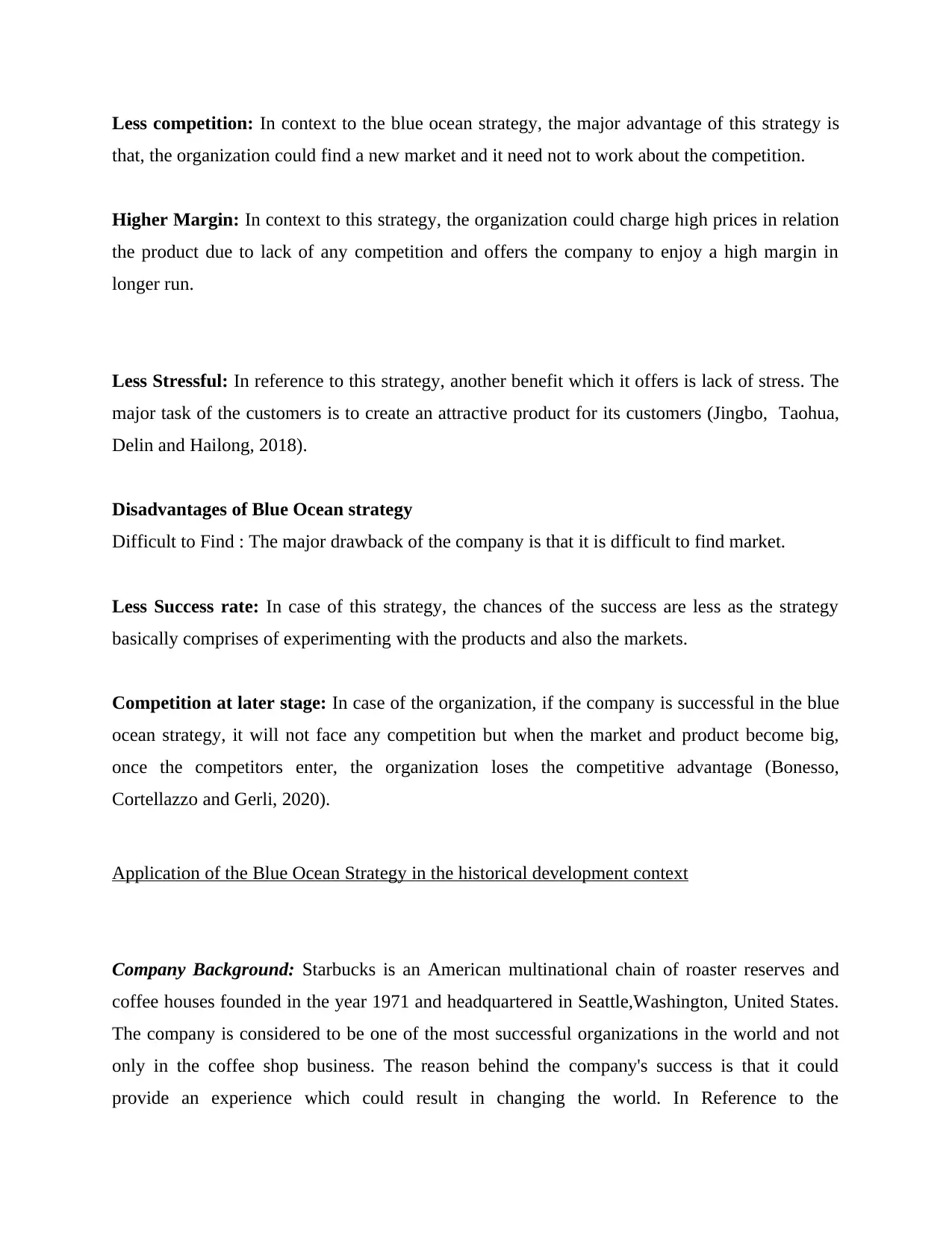
Less competition: In context to the blue ocean strategy, the major advantage of this strategy is
that, the organization could find a new market and it need not to work about the competition.
Higher Margin: In context to this strategy, the organization could charge high prices in relation
the product due to lack of any competition and offers the company to enjoy a high margin in
longer run.
Less Stressful: In reference to this strategy, another benefit which it offers is lack of stress. The
major task of the customers is to create an attractive product for its customers (Jingbo, Taohua,
Delin and Hailong, 2018).
Disadvantages of Blue Ocean strategy
Difficult to Find : The major drawback of the company is that it is difficult to find market.
Less Success rate: In case of this strategy, the chances of the success are less as the strategy
basically comprises of experimenting with the products and also the markets.
Competition at later stage: In case of the organization, if the company is successful in the blue
ocean strategy, it will not face any competition but when the market and product become big,
once the competitors enter, the organization loses the competitive advantage (Bonesso,
Cortellazzo and Gerli, 2020).
Application of the Blue Ocean Strategy in the historical development context
Company Background: Starbucks is an American multinational chain of roaster reserves and
coffee houses founded in the year 1971 and headquartered in Seattle,Washington, United States.
The company is considered to be one of the most successful organizations in the world and not
only in the coffee shop business. The reason behind the company's success is that it could
provide an experience which could result in changing the world. In Reference to the
that, the organization could find a new market and it need not to work about the competition.
Higher Margin: In context to this strategy, the organization could charge high prices in relation
the product due to lack of any competition and offers the company to enjoy a high margin in
longer run.
Less Stressful: In reference to this strategy, another benefit which it offers is lack of stress. The
major task of the customers is to create an attractive product for its customers (Jingbo, Taohua,
Delin and Hailong, 2018).
Disadvantages of Blue Ocean strategy
Difficult to Find : The major drawback of the company is that it is difficult to find market.
Less Success rate: In case of this strategy, the chances of the success are less as the strategy
basically comprises of experimenting with the products and also the markets.
Competition at later stage: In case of the organization, if the company is successful in the blue
ocean strategy, it will not face any competition but when the market and product become big,
once the competitors enter, the organization loses the competitive advantage (Bonesso,
Cortellazzo and Gerli, 2020).
Application of the Blue Ocean Strategy in the historical development context
Company Background: Starbucks is an American multinational chain of roaster reserves and
coffee houses founded in the year 1971 and headquartered in Seattle,Washington, United States.
The company is considered to be one of the most successful organizations in the world and not
only in the coffee shop business. The reason behind the company's success is that it could
provide an experience which could result in changing the world. In Reference to the
Paraphrase This Document
Need a fresh take? Get an instant paraphrase of this document with our AI Paraphraser
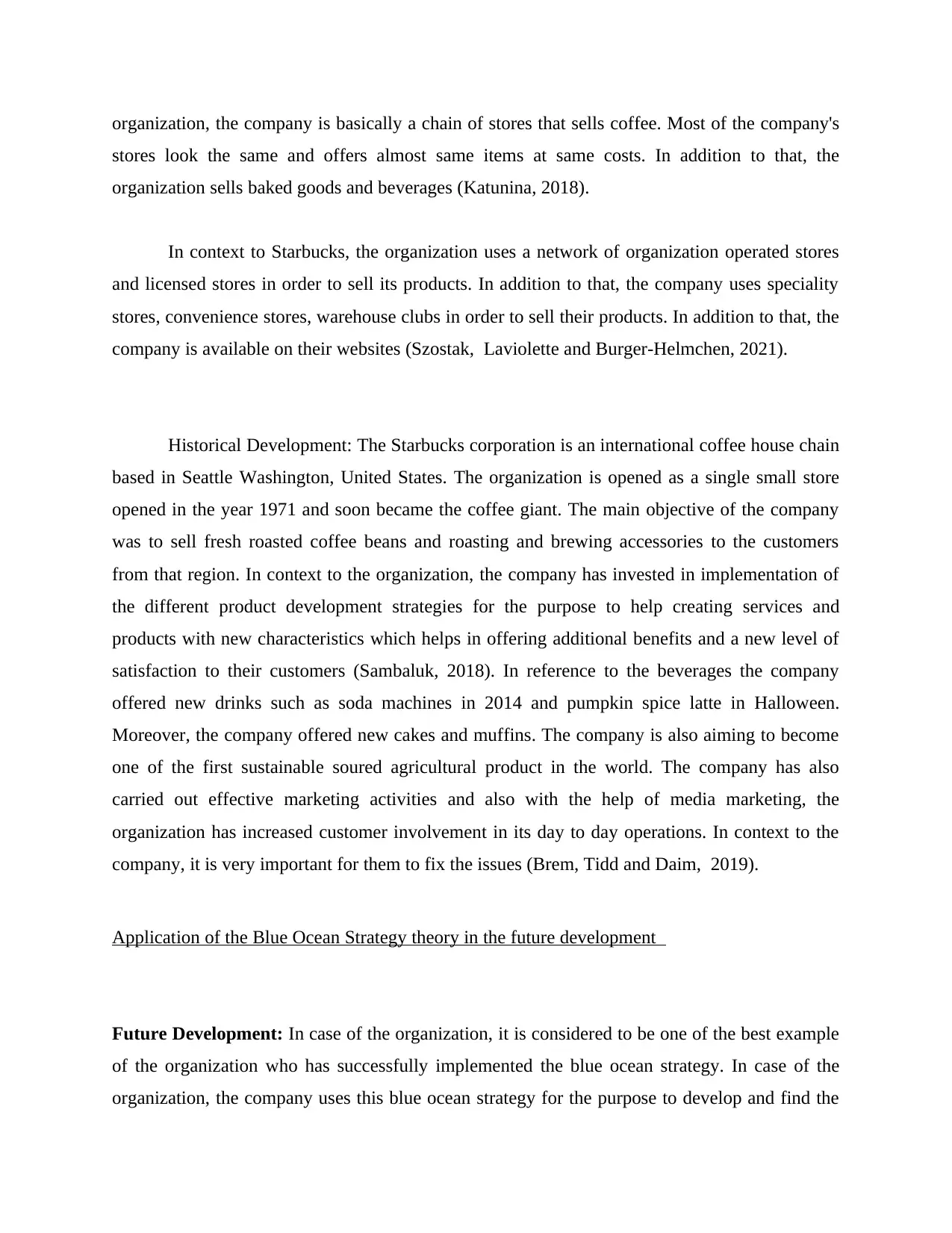
organization, the company is basically a chain of stores that sells coffee. Most of the company's
stores look the same and offers almost same items at same costs. In addition to that, the
organization sells baked goods and beverages (Katunina, 2018).
In context to Starbucks, the organization uses a network of organization operated stores
and licensed stores in order to sell its products. In addition to that, the company uses speciality
stores, convenience stores, warehouse clubs in order to sell their products. In addition to that, the
company is available on their websites (Szostak, Laviolette and Burger-Helmchen, 2021).
Historical Development: The Starbucks corporation is an international coffee house chain
based in Seattle Washington, United States. The organization is opened as a single small store
opened in the year 1971 and soon became the coffee giant. The main objective of the company
was to sell fresh roasted coffee beans and roasting and brewing accessories to the customers
from that region. In context to the organization, the company has invested in implementation of
the different product development strategies for the purpose to help creating services and
products with new characteristics which helps in offering additional benefits and a new level of
satisfaction to their customers (Sambaluk, 2018). In reference to the beverages the company
offered new drinks such as soda machines in 2014 and pumpkin spice latte in Halloween.
Moreover, the company offered new cakes and muffins. The company is also aiming to become
one of the first sustainable soured agricultural product in the world. The company has also
carried out effective marketing activities and also with the help of media marketing, the
organization has increased customer involvement in its day to day operations. In context to the
company, it is very important for them to fix the issues (Brem, Tidd and Daim, 2019).
Application of the Blue Ocean Strategy theory in the future development
Future Development: In case of the organization, it is considered to be one of the best example
of the organization who has successfully implemented the blue ocean strategy. In case of the
organization, the company uses this blue ocean strategy for the purpose to develop and find the
stores look the same and offers almost same items at same costs. In addition to that, the
organization sells baked goods and beverages (Katunina, 2018).
In context to Starbucks, the organization uses a network of organization operated stores
and licensed stores in order to sell its products. In addition to that, the company uses speciality
stores, convenience stores, warehouse clubs in order to sell their products. In addition to that, the
company is available on their websites (Szostak, Laviolette and Burger-Helmchen, 2021).
Historical Development: The Starbucks corporation is an international coffee house chain
based in Seattle Washington, United States. The organization is opened as a single small store
opened in the year 1971 and soon became the coffee giant. The main objective of the company
was to sell fresh roasted coffee beans and roasting and brewing accessories to the customers
from that region. In context to the organization, the company has invested in implementation of
the different product development strategies for the purpose to help creating services and
products with new characteristics which helps in offering additional benefits and a new level of
satisfaction to their customers (Sambaluk, 2018). In reference to the beverages the company
offered new drinks such as soda machines in 2014 and pumpkin spice latte in Halloween.
Moreover, the company offered new cakes and muffins. The company is also aiming to become
one of the first sustainable soured agricultural product in the world. The company has also
carried out effective marketing activities and also with the help of media marketing, the
organization has increased customer involvement in its day to day operations. In context to the
company, it is very important for them to fix the issues (Brem, Tidd and Daim, 2019).
Application of the Blue Ocean Strategy theory in the future development
Future Development: In case of the organization, it is considered to be one of the best example
of the organization who has successfully implemented the blue ocean strategy. In case of the
organization, the company uses this blue ocean strategy for the purpose to develop and find the
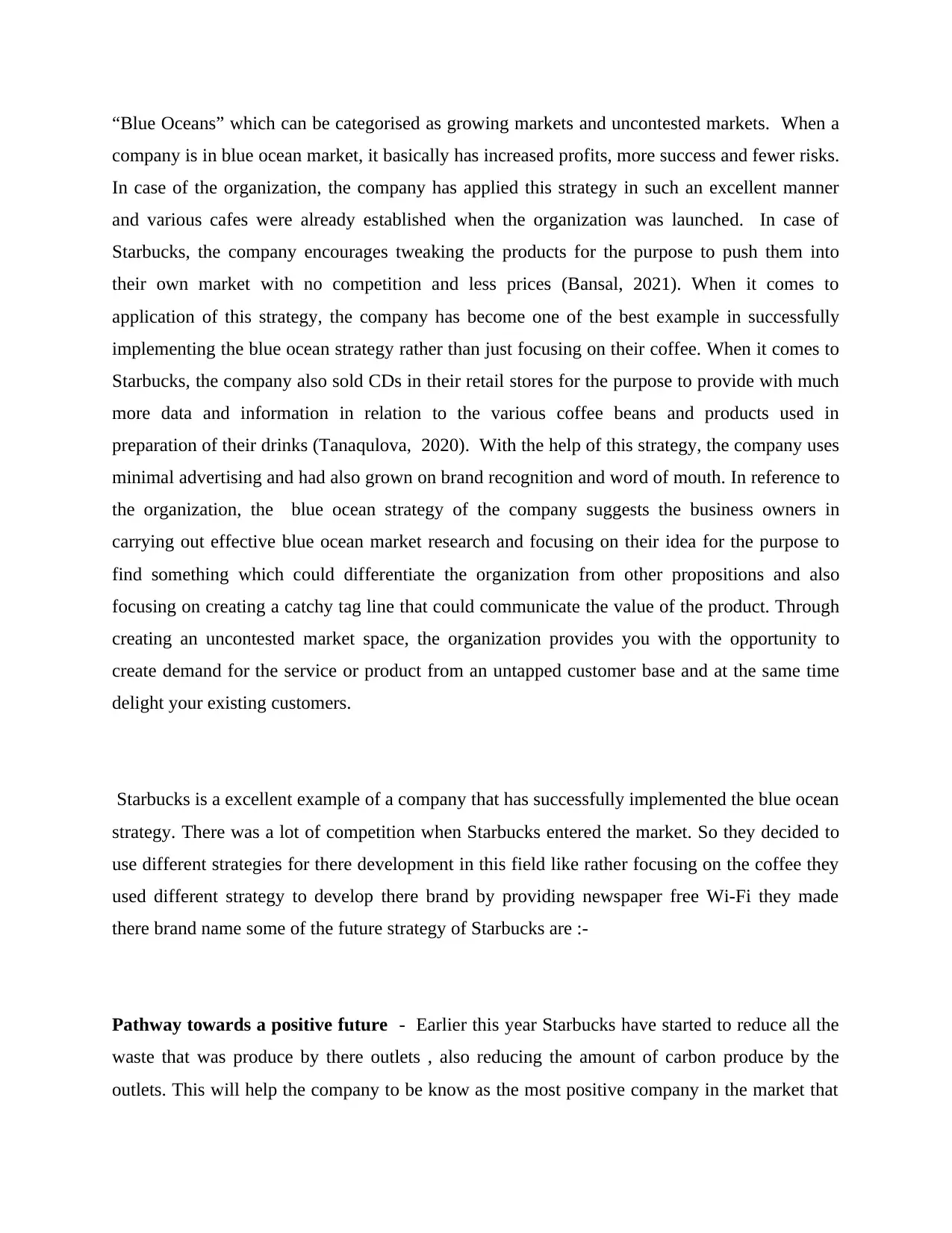
“Blue Oceans” which can be categorised as growing markets and uncontested markets. When a
company is in blue ocean market, it basically has increased profits, more success and fewer risks.
In case of the organization, the company has applied this strategy in such an excellent manner
and various cafes were already established when the organization was launched. In case of
Starbucks, the company encourages tweaking the products for the purpose to push them into
their own market with no competition and less prices (Bansal, 2021). When it comes to
application of this strategy, the company has become one of the best example in successfully
implementing the blue ocean strategy rather than just focusing on their coffee. When it comes to
Starbucks, the company also sold CDs in their retail stores for the purpose to provide with much
more data and information in relation to the various coffee beans and products used in
preparation of their drinks (Tanaqulova, 2020). With the help of this strategy, the company uses
minimal advertising and had also grown on brand recognition and word of mouth. In reference to
the organization, the blue ocean strategy of the company suggests the business owners in
carrying out effective blue ocean market research and focusing on their idea for the purpose to
find something which could differentiate the organization from other propositions and also
focusing on creating a catchy tag line that could communicate the value of the product. Through
creating an uncontested market space, the organization provides you with the opportunity to
create demand for the service or product from an untapped customer base and at the same time
delight your existing customers.
Starbucks is a excellent example of a company that has successfully implemented the blue ocean
strategy. There was a lot of competition when Starbucks entered the market. So they decided to
use different strategies for there development in this field like rather focusing on the coffee they
used different strategy to develop there brand by providing newspaper free Wi-Fi they made
there brand name some of the future strategy of Starbucks are :-
Pathway towards a positive future - Earlier this year Starbucks have started to reduce all the
waste that was produce by there outlets , also reducing the amount of carbon produce by the
outlets. This will help the company to be know as the most positive company in the market that
company is in blue ocean market, it basically has increased profits, more success and fewer risks.
In case of the organization, the company has applied this strategy in such an excellent manner
and various cafes were already established when the organization was launched. In case of
Starbucks, the company encourages tweaking the products for the purpose to push them into
their own market with no competition and less prices (Bansal, 2021). When it comes to
application of this strategy, the company has become one of the best example in successfully
implementing the blue ocean strategy rather than just focusing on their coffee. When it comes to
Starbucks, the company also sold CDs in their retail stores for the purpose to provide with much
more data and information in relation to the various coffee beans and products used in
preparation of their drinks (Tanaqulova, 2020). With the help of this strategy, the company uses
minimal advertising and had also grown on brand recognition and word of mouth. In reference to
the organization, the blue ocean strategy of the company suggests the business owners in
carrying out effective blue ocean market research and focusing on their idea for the purpose to
find something which could differentiate the organization from other propositions and also
focusing on creating a catchy tag line that could communicate the value of the product. Through
creating an uncontested market space, the organization provides you with the opportunity to
create demand for the service or product from an untapped customer base and at the same time
delight your existing customers.
Starbucks is a excellent example of a company that has successfully implemented the blue ocean
strategy. There was a lot of competition when Starbucks entered the market. So they decided to
use different strategies for there development in this field like rather focusing on the coffee they
used different strategy to develop there brand by providing newspaper free Wi-Fi they made
there brand name some of the future strategy of Starbucks are :-
Pathway towards a positive future - Earlier this year Starbucks have started to reduce all the
waste that was produce by there outlets , also reducing the amount of carbon produce by the
outlets. This will help the company to be know as the most positive company in the market that
⊘ This is a preview!⊘
Do you want full access?
Subscribe today to unlock all pages.

Trusted by 1+ million students worldwide
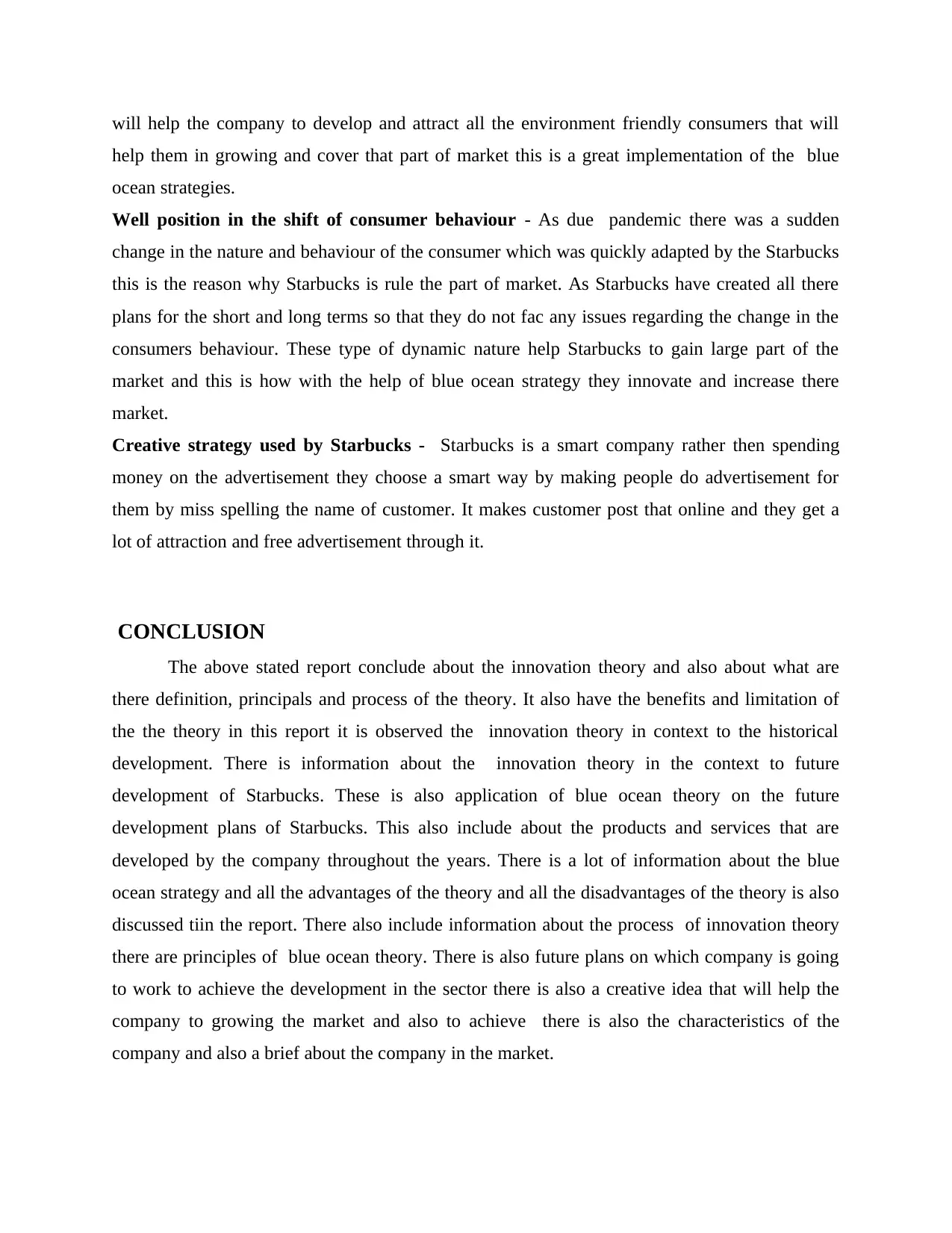
will help the company to develop and attract all the environment friendly consumers that will
help them in growing and cover that part of market this is a great implementation of the blue
ocean strategies.
Well position in the shift of consumer behaviour - As due pandemic there was a sudden
change in the nature and behaviour of the consumer which was quickly adapted by the Starbucks
this is the reason why Starbucks is rule the part of market. As Starbucks have created all there
plans for the short and long terms so that they do not fac any issues regarding the change in the
consumers behaviour. These type of dynamic nature help Starbucks to gain large part of the
market and this is how with the help of blue ocean strategy they innovate and increase there
market.
Creative strategy used by Starbucks - Starbucks is a smart company rather then spending
money on the advertisement they choose a smart way by making people do advertisement for
them by miss spelling the name of customer. It makes customer post that online and they get a
lot of attraction and free advertisement through it.
CONCLUSION
The above stated report conclude about the innovation theory and also about what are
there definition, principals and process of the theory. It also have the benefits and limitation of
the the theory in this report it is observed the innovation theory in context to the historical
development. There is information about the innovation theory in the context to future
development of Starbucks. These is also application of blue ocean theory on the future
development plans of Starbucks. This also include about the products and services that are
developed by the company throughout the years. There is a lot of information about the blue
ocean strategy and all the advantages of the theory and all the disadvantages of the theory is also
discussed tiin the report. There also include information about the process of innovation theory
there are principles of blue ocean theory. There is also future plans on which company is going
to work to achieve the development in the sector there is also a creative idea that will help the
company to growing the market and also to achieve there is also the characteristics of the
company and also a brief about the company in the market.
help them in growing and cover that part of market this is a great implementation of the blue
ocean strategies.
Well position in the shift of consumer behaviour - As due pandemic there was a sudden
change in the nature and behaviour of the consumer which was quickly adapted by the Starbucks
this is the reason why Starbucks is rule the part of market. As Starbucks have created all there
plans for the short and long terms so that they do not fac any issues regarding the change in the
consumers behaviour. These type of dynamic nature help Starbucks to gain large part of the
market and this is how with the help of blue ocean strategy they innovate and increase there
market.
Creative strategy used by Starbucks - Starbucks is a smart company rather then spending
money on the advertisement they choose a smart way by making people do advertisement for
them by miss spelling the name of customer. It makes customer post that online and they get a
lot of attraction and free advertisement through it.
CONCLUSION
The above stated report conclude about the innovation theory and also about what are
there definition, principals and process of the theory. It also have the benefits and limitation of
the the theory in this report it is observed the innovation theory in context to the historical
development. There is information about the innovation theory in the context to future
development of Starbucks. These is also application of blue ocean theory on the future
development plans of Starbucks. This also include about the products and services that are
developed by the company throughout the years. There is a lot of information about the blue
ocean strategy and all the advantages of the theory and all the disadvantages of the theory is also
discussed tiin the report. There also include information about the process of innovation theory
there are principles of blue ocean theory. There is also future plans on which company is going
to work to achieve the development in the sector there is also a creative idea that will help the
company to growing the market and also to achieve there is also the characteristics of the
company and also a brief about the company in the market.
Paraphrase This Document
Need a fresh take? Get an instant paraphrase of this document with our AI Paraphraser

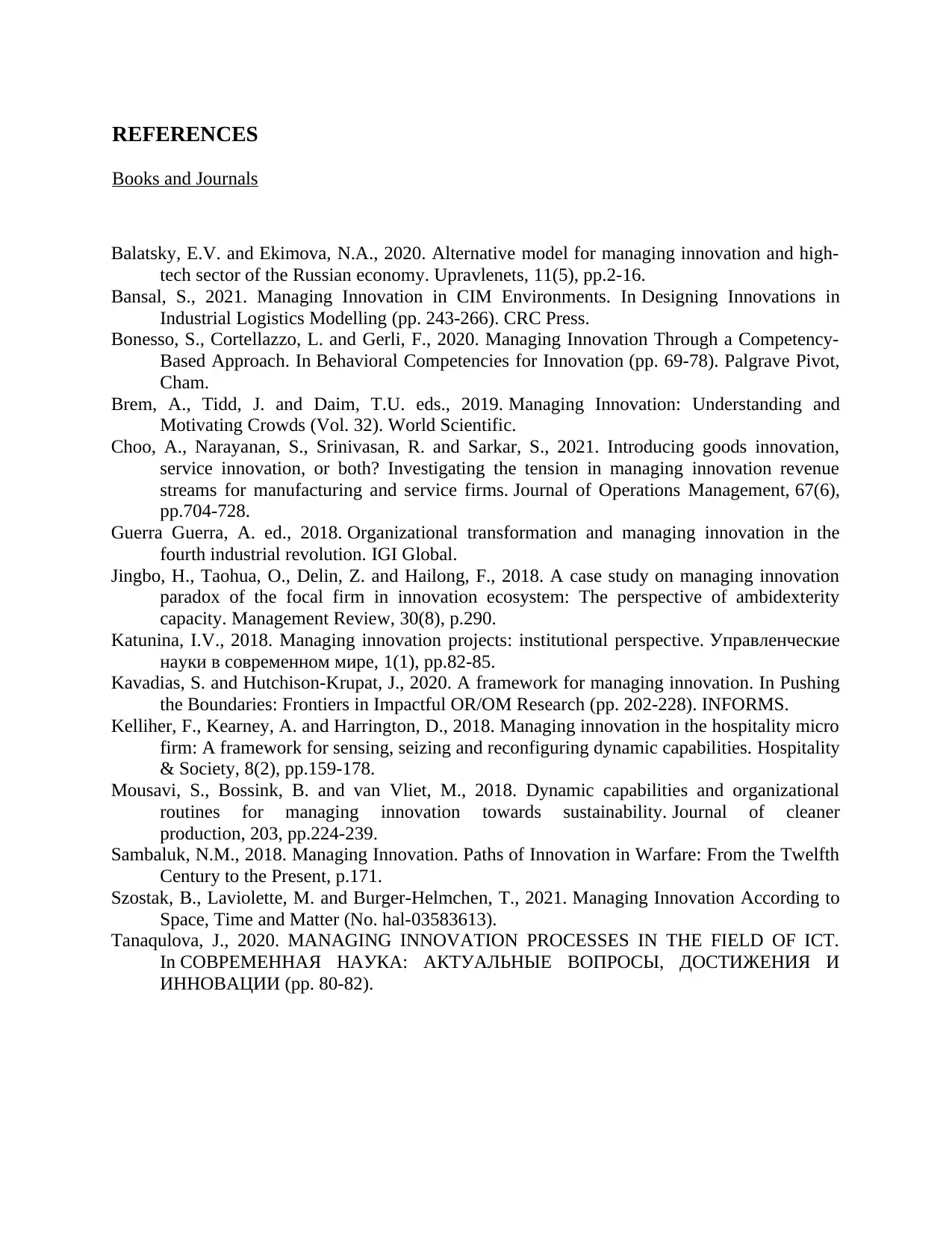
REFERENCES
Books and Journals
Balatsky, E.V. and Ekimova, N.A., 2020. Alternative model for managing innovation and high-
tech sector of the Russian economy. Upravlenets, 11(5), pp.2-16.
Bansal, S., 2021. Managing Innovation in CIM Environments. In Designing Innovations in
Industrial Logistics Modelling (pp. 243-266). CRC Press.
Bonesso, S., Cortellazzo, L. and Gerli, F., 2020. Managing Innovation Through a Competency-
Based Approach. In Behavioral Competencies for Innovation (pp. 69-78). Palgrave Pivot,
Cham.
Brem, A., Tidd, J. and Daim, T.U. eds., 2019. Managing Innovation: Understanding and
Motivating Crowds (Vol. 32). World Scientific.
Choo, A., Narayanan, S., Srinivasan, R. and Sarkar, S., 2021. Introducing goods innovation,
service innovation, or both? Investigating the tension in managing innovation revenue
streams for manufacturing and service firms. Journal of Operations Management, 67(6),
pp.704-728.
Guerra Guerra, A. ed., 2018. Organizational transformation and managing innovation in the
fourth industrial revolution. IGI Global.
Jingbo, H., Taohua, O., Delin, Z. and Hailong, F., 2018. A case study on managing innovation
paradox of the focal firm in innovation ecosystem: The perspective of ambidexterity
capacity. Management Review, 30(8), p.290.
Katunina, I.V., 2018. Managing innovation projects: institutional perspective. Управленческие
науки в современном мире, 1(1), pp.82-85.
Kavadias, S. and Hutchison-Krupat, J., 2020. A framework for managing innovation. In Pushing
the Boundaries: Frontiers in Impactful OR/OM Research (pp. 202-228). INFORMS.
Kelliher, F., Kearney, A. and Harrington, D., 2018. Managing innovation in the hospitality micro
firm: A framework for sensing, seizing and reconfiguring dynamic capabilities. Hospitality
& Society, 8(2), pp.159-178.
Mousavi, S., Bossink, B. and van Vliet, M., 2018. Dynamic capabilities and organizational
routines for managing innovation towards sustainability. Journal of cleaner
production, 203, pp.224-239.
Sambaluk, N.M., 2018. Managing Innovation. Paths of Innovation in Warfare: From the Twelfth
Century to the Present, p.171.
Szostak, B., Laviolette, M. and Burger-Helmchen, T., 2021. Managing Innovation According to
Space, Time and Matter (No. hal-03583613).
Tanaqulova, J., 2020. MANAGING INNOVATION PROCESSES IN THE FIELD OF ICT.
In СОВРЕМЕННАЯ НАУКА: АКТУАЛЬНЫЕ ВОПРОСЫ, ДОСТИЖЕНИЯ И
ИННОВАЦИИ (pp. 80-82).
Books and Journals
Balatsky, E.V. and Ekimova, N.A., 2020. Alternative model for managing innovation and high-
tech sector of the Russian economy. Upravlenets, 11(5), pp.2-16.
Bansal, S., 2021. Managing Innovation in CIM Environments. In Designing Innovations in
Industrial Logistics Modelling (pp. 243-266). CRC Press.
Bonesso, S., Cortellazzo, L. and Gerli, F., 2020. Managing Innovation Through a Competency-
Based Approach. In Behavioral Competencies for Innovation (pp. 69-78). Palgrave Pivot,
Cham.
Brem, A., Tidd, J. and Daim, T.U. eds., 2019. Managing Innovation: Understanding and
Motivating Crowds (Vol. 32). World Scientific.
Choo, A., Narayanan, S., Srinivasan, R. and Sarkar, S., 2021. Introducing goods innovation,
service innovation, or both? Investigating the tension in managing innovation revenue
streams for manufacturing and service firms. Journal of Operations Management, 67(6),
pp.704-728.
Guerra Guerra, A. ed., 2018. Organizational transformation and managing innovation in the
fourth industrial revolution. IGI Global.
Jingbo, H., Taohua, O., Delin, Z. and Hailong, F., 2018. A case study on managing innovation
paradox of the focal firm in innovation ecosystem: The perspective of ambidexterity
capacity. Management Review, 30(8), p.290.
Katunina, I.V., 2018. Managing innovation projects: institutional perspective. Управленческие
науки в современном мире, 1(1), pp.82-85.
Kavadias, S. and Hutchison-Krupat, J., 2020. A framework for managing innovation. In Pushing
the Boundaries: Frontiers in Impactful OR/OM Research (pp. 202-228). INFORMS.
Kelliher, F., Kearney, A. and Harrington, D., 2018. Managing innovation in the hospitality micro
firm: A framework for sensing, seizing and reconfiguring dynamic capabilities. Hospitality
& Society, 8(2), pp.159-178.
Mousavi, S., Bossink, B. and van Vliet, M., 2018. Dynamic capabilities and organizational
routines for managing innovation towards sustainability. Journal of cleaner
production, 203, pp.224-239.
Sambaluk, N.M., 2018. Managing Innovation. Paths of Innovation in Warfare: From the Twelfth
Century to the Present, p.171.
Szostak, B., Laviolette, M. and Burger-Helmchen, T., 2021. Managing Innovation According to
Space, Time and Matter (No. hal-03583613).
Tanaqulova, J., 2020. MANAGING INNOVATION PROCESSES IN THE FIELD OF ICT.
In СОВРЕМЕННАЯ НАУКА: АКТУАЛЬНЫЕ ВОПРОСЫ, ДОСТИЖЕНИЯ И
ИННОВАЦИИ (pp. 80-82).
⊘ This is a preview!⊘
Do you want full access?
Subscribe today to unlock all pages.

Trusted by 1+ million students worldwide
1 out of 12
Related Documents
Your All-in-One AI-Powered Toolkit for Academic Success.
+13062052269
info@desklib.com
Available 24*7 on WhatsApp / Email
![[object Object]](/_next/static/media/star-bottom.7253800d.svg)
Unlock your academic potential
Copyright © 2020–2025 A2Z Services. All Rights Reserved. Developed and managed by ZUCOL.





